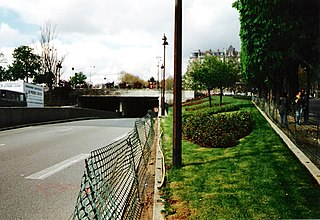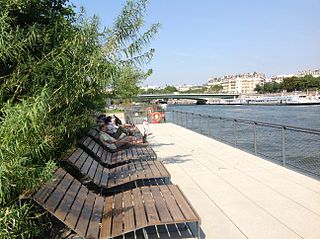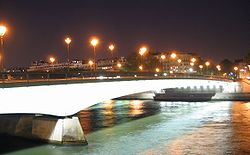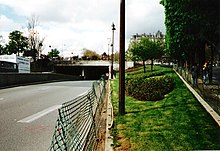
The Seine is a 777-kilometre-long (483 mi) river in northern France. Its drainage basin is in the Paris Basin covering most of northern France. It rises at Source-Seine, 30 kilometres (19 mi) northwest of Dijon in northeastern France in the Langres plateau, flowing through Paris and into the English Channel at Le Havre. It is navigable by ocean-going vessels as far as Rouen, 120 kilometres (75 mi) from the sea. Over 60 percent of its length, as far as Burgundy, is negotiable by large barges and most tour boats, and nearly its whole length is available for recreational boating; excursion boats offer sightseeing tours of the river banks in the capital city, Paris.

Emad El-Din Mohamed Abdel Mena'em Fayed, commonly known as Dodi Fayed, was an Egyptian film producer and the eldest child of the businessman Mohamed Al-Fayed. He was romantically involved with Diana, Princess of Wales, when they both died in a car crash in Paris on 31 August 1997.

The Battle of the Alma took place during the Crimean War between an allied expeditionary force and Russian forces defending the Crimean Peninsula on 20 September 1854. The allies had made a surprise landing in Crimea on 14 September. The allied commanders, Maréchal Jacques Leroy de Saint-Arnaud and Lord Raglan, then marched toward the strategically important port city of Sevastopol, 45 km (28 mi) away. Russian commander Prince Alexander Sergeyevich Menshikov rushed his available forces to the last natural defensive position before the city, the Alma Heights, south of the Alma River.

The Quai d'Orsay is a quay in the 7th arrondissement of Paris. It is part of the left bank of the Seine opposite the Place de la Concorde. The Quai becomes the Quai Anatole-France east of the Palais Bourbon, and the Quai Branly west of the Pont de l'Alma.

The Flame of Liberty in Paris is a full-sized, gold-leaf-covered replica of the flame of the torch from the Statue of Liberty. The monument, which measures approximately 3.5 metres in height, is a sculpture of a flame, executed in gilded copper, supported by a pedestal of gray-and-black marble. It is located near the northern end of the Pont de l'Alma, on the Place Diana, in the 16th arrondissement.

During the early hours of 31 August 1997, Diana, Princess of Wales, died from injuries sustained earlier that night in a fatal car crash in the Pont de l'Alma tunnel in Paris, France. Diana's partner, Dodi Fayed, and the driver of the Mercedes-Benz W140, Henri Paul, were found dead inside the car. Dodi's bodyguard, Trevor Rees-Jones, was seriously injured and was the only survivor of the crash.

Alma–Marceau is a station on Line 9 of the Paris Métro, named after the Pont de l'Alma and the Avenue Marceau. The station opened on 27 May 1923 with the extension of the line from Trocadéro to Saint-Augustin.

The Pont de Bir-Hakeim, formerly the Pont de Passy, is an arch bridge that crosses the Seine in Paris. It connects the 15th and 16th arrondissement, passing through the Île aux Cygnes. The bridge, made of steel, was constructed between 1903 and 1905, in replacement of a footbridge that had been erected in 1878. The bridge has two levels: one for motor vehicles and pedestrians, the other being a viaduct built above the first one, through which passes Line 6 of the Paris Métro. The bridge is 237 metres (777 ft) long and 24.7 metres (81 ft) wide. The part crossing the Grand Bras of the Seine is slightly longer than the one crossing the Petit Bras.

Diana: Last Days of a Princess is a television movie broadcast in the United States by TLC on 12 August 2007 and subsequent dates. It also has aired on Five, UKTV History and UKTV Drama in the United Kingdom, RTÉ in Ireland, ProSieben in Germany, TF1 in France, RTP in Portugal, Channel 7 in Australia, Channel One in Russia, Jim in Finland and the History Channel in India.

The Pont de la Tournelle, is an arch bridge spanning the river Seine in Paris.
The Pont Notre-Dame is a bridge that crosses the Seine in Paris, France linking the quai de Gesvres on the Rive Droite with the quai de la Corse on the Île de la Cité. The bridge is noted for being the "most ancient" in Paris, in the sense that, while the oldest bridge in Paris that is in its original state is undoubtedly the Pont Neuf, a bridge in some form has existed at the site of the Pont Notre-Dame since antiquity; nonetheless, it has been destroyed and reconstructed numerous times, a fact referred to in the Latin inscription on it to honor its Italian architect, Fra Giovanni Giocondo. The bridge once was lined with approximately sixty houses, the weight of which caused a collapse in 1499.

Charles Auguste Arnaud, known as Auguste Arnaud was a French sculptor.

The redoute de Gravelle is a fort in Joinville-le-Pont, situated to the south-east of Vincennes in Paris. Built under Louis-Philippe, from 1968 it housed the École nationale de police de Paris (ENPP), before becoming an illegal immigrants detention centre. Its south face is decorated with Auguste Arnaud's statue of a skirmisher, formerly placed next to one of a zouave on the old pont de l'Alma, but moved to its present position after the construction of the A4 autoroute in 1973. The statue is visible from the A4.

Georges Diebolt, sometimes spelled Diébolt, was a French sculptor best known for his publicly commissioned monumental works, including The Zouave and Grenadier on the pont de l'Alma in Paris and the Maritime Victory on the Pont des Invalides.

There are many conspiracy theories surrounding the death of Diana, Princess of Wales, on 31 August 1997. Official investigations in both Britain and France found that Diana died in a manner consistent with media reports following the fatal car crash in Paris. In 1999, a French investigation concluded that Diana died as the result of a crash. The French investigator, Judge Hervé Stephan, concluded that the paparazzi were some distance from the Mercedes S280 when it crashed and were not responsible for manslaughter. After hearing evidence at the British inquest, a jury in 2008 returned a verdict of "unlawful killing" by driver Henri Paul and the paparazzi pursuing the car. The jury's verdict also stated: "In addition, the death of the deceased was caused or contributed to by the fact that the deceased were not wearing a seat belt and by the fact that the Mercedes struck the pillar in the Pont de l'Alma tunnel rather than colliding with something else."

The Little White Car is a novel by British author Dan Rhodes, published under the pen name Danuta de Rhodes in 2004 by Canongate. It has been translated into 12 languages. The book is based on an imaginative fictional elaboration of the actual forensic evidence that the Mercedes carrying Diana, Princess of Wales had had a glancing contact with another car, believed to be a white Fiat Uno at some point before it crashed in the Pont de l'Alma tunnel in Paris on 31 August 1997. The French investigation did not identify the car or the driver. A conspiracy theory developed around the white Fiat Uno.

Diana is a 2013 biographical drama film directed by Oliver Hirschbiegel, about the last two years of the life of Diana, Princess of Wales. The screenplay is based on Kate Snell's 2001 book, Diana: Her Last Love, and was written by Stephen Jeffreys. British actress Naomi Watts plays the title role of Diana.

The Promenade des Berges de la Seine is a public park and promenade located along the left bank of the Seine river in the 7th arrondissement of Paris, between the Pont de l'Alma and the Musée d'Orsay. The promenade, created on the former highway that ran along the left bank, includes five floating gardens, planted atop barges, plus exhibition areas, performance and classroom spaces, playgrounds, sports facilities and cafes. Begun in 2008, it was opened by Mayor Bertrand Delanoë on June 19, 2013. Everything in the park can be dismantled and moved within 24 hours if the water of the river rises too high.

The Zouave is an 1856 stone statue by French artist Georges Diebolt, which has been sited on the Pont de l'Alma in Paris since the 1850s. The statue is used as an informal flood marker for the level of the River Seine in Paris.

The Place Diana is a public square situated in the 16th arrondissement of Paris, near the Seine river.






















